MBA Strategic Management Project: A Deep Dive into Nokia's Strategies
VerifiedAdded on 2021/10/10
|19
|4674
|186
Project
AI Summary
This project presents a comprehensive strategic management analysis of Nokia Corporation, examining its evolution, business strategies, and the challenges it faced, particularly in the smartphone market. The report delves into Nokia's history, mission, vision, and values, highlighting key strategic decisions and operational issues. It explores conceptual factors, including the impact of technology and market changes, and analyzes financial aspects and competitor dynamics. The analysis covers both external environmental factors and internal factors, such as organizational structure and processes, that influenced Nokia's performance. The project concludes with recommended alternative strategies and priority actions, providing insights into how Nokia could have navigated its challenges. The project aims to provide a detailed overview of Nokia's strategic management, offering valuable insights for understanding the company's trajectory and strategic decision-making processes.
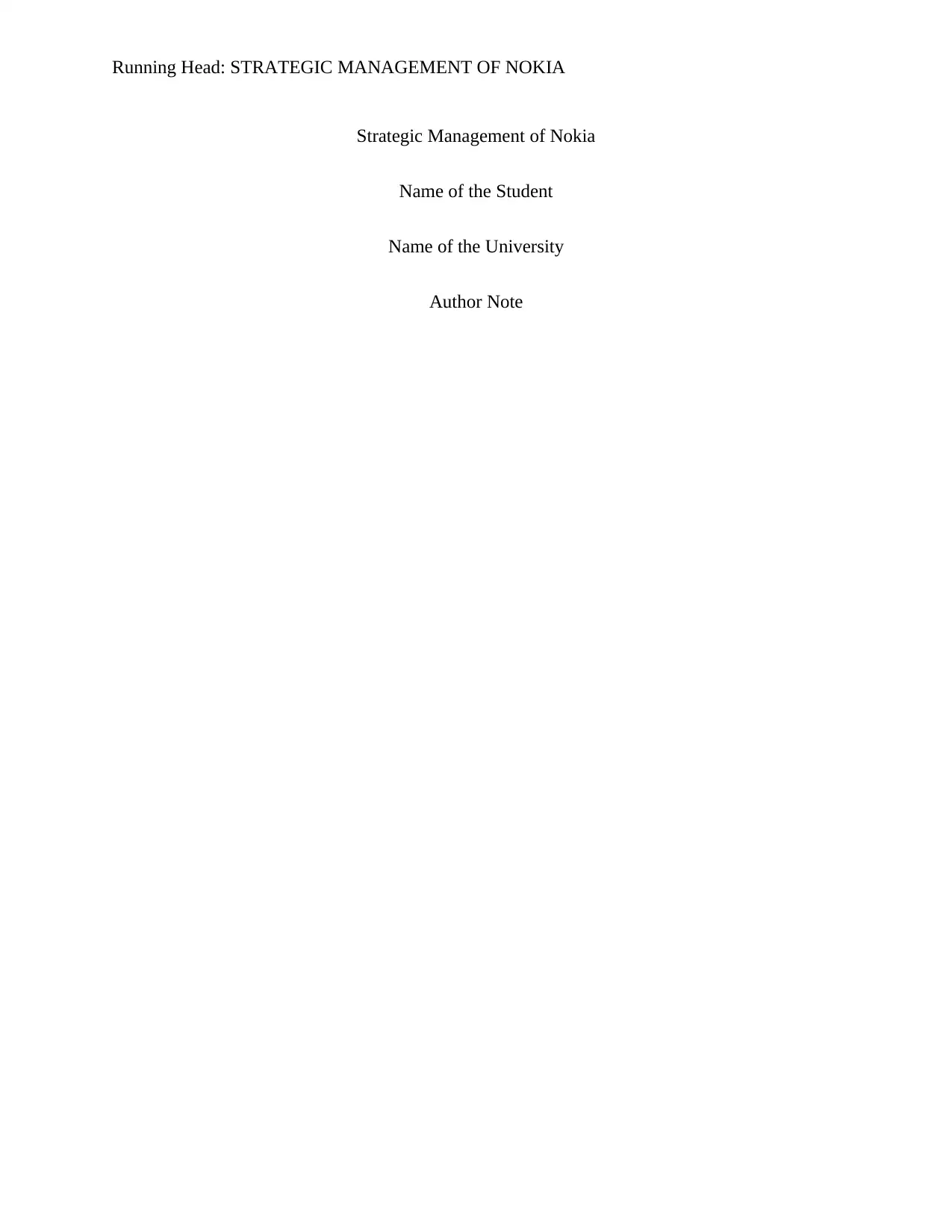
Running Head: STRATEGIC MANAGEMENT OF NOKIA
Strategic Management of Nokia
Name of the Student
Name of the University
Author Note
Strategic Management of Nokia
Name of the Student
Name of the University
Author Note
Paraphrase This Document
Need a fresh take? Get an instant paraphrase of this document with our AI Paraphraser
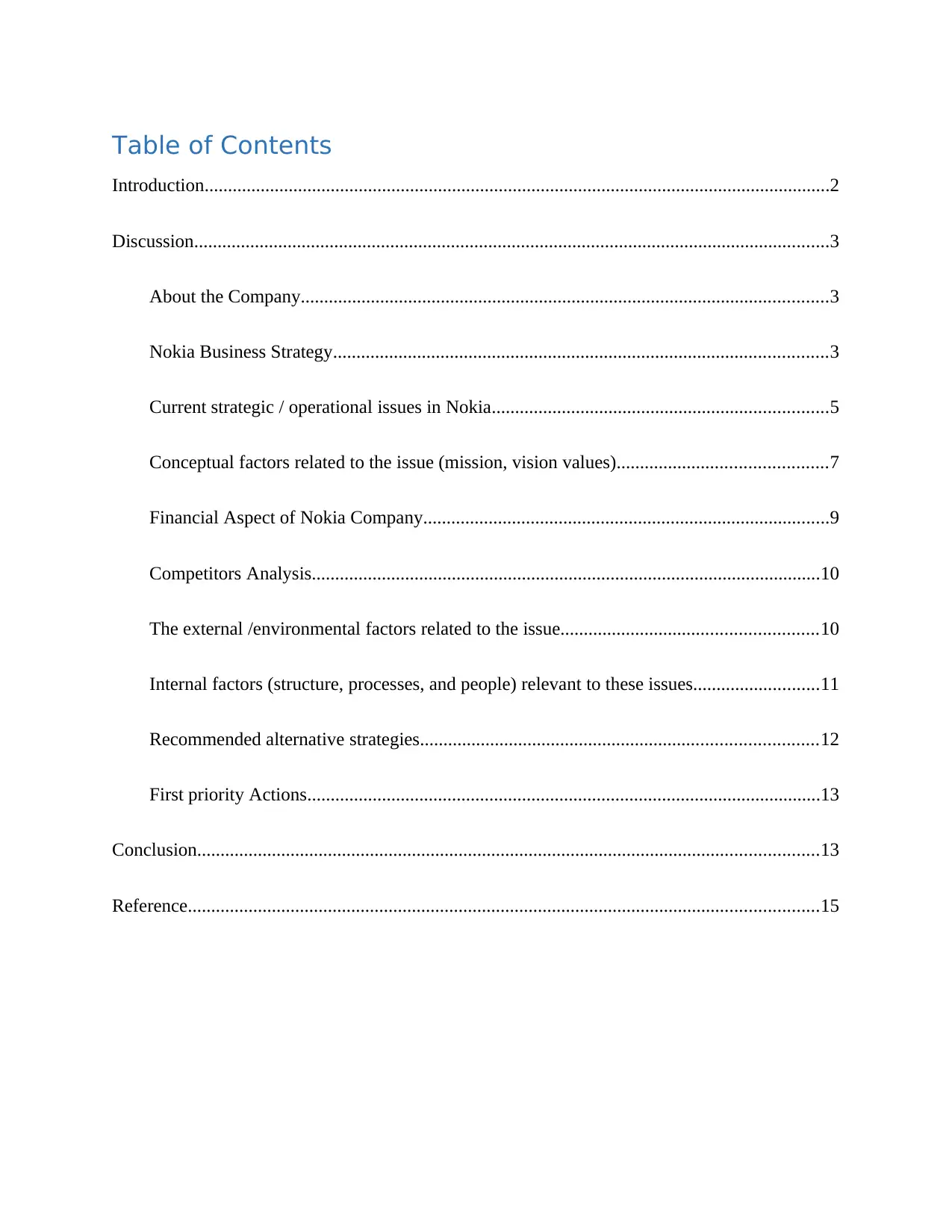
Table of Contents
Introduction......................................................................................................................................2
Discussion........................................................................................................................................3
About the Company.................................................................................................................3
Nokia Business Strategy..........................................................................................................3
Current strategic / operational issues in Nokia........................................................................5
Conceptual factors related to the issue (mission, vision values).............................................7
Financial Aspect of Nokia Company.......................................................................................9
Competitors Analysis.............................................................................................................10
The external /environmental factors related to the issue.......................................................10
Internal factors (structure, processes, and people) relevant to these issues...........................11
Recommended alternative strategies.....................................................................................12
First priority Actions..............................................................................................................13
Conclusion.....................................................................................................................................13
Reference.......................................................................................................................................15
Introduction......................................................................................................................................2
Discussion........................................................................................................................................3
About the Company.................................................................................................................3
Nokia Business Strategy..........................................................................................................3
Current strategic / operational issues in Nokia........................................................................5
Conceptual factors related to the issue (mission, vision values).............................................7
Financial Aspect of Nokia Company.......................................................................................9
Competitors Analysis.............................................................................................................10
The external /environmental factors related to the issue.......................................................10
Internal factors (structure, processes, and people) relevant to these issues...........................11
Recommended alternative strategies.....................................................................................12
First priority Actions..............................................................................................................13
Conclusion.....................................................................................................................................13
Reference.......................................................................................................................................15
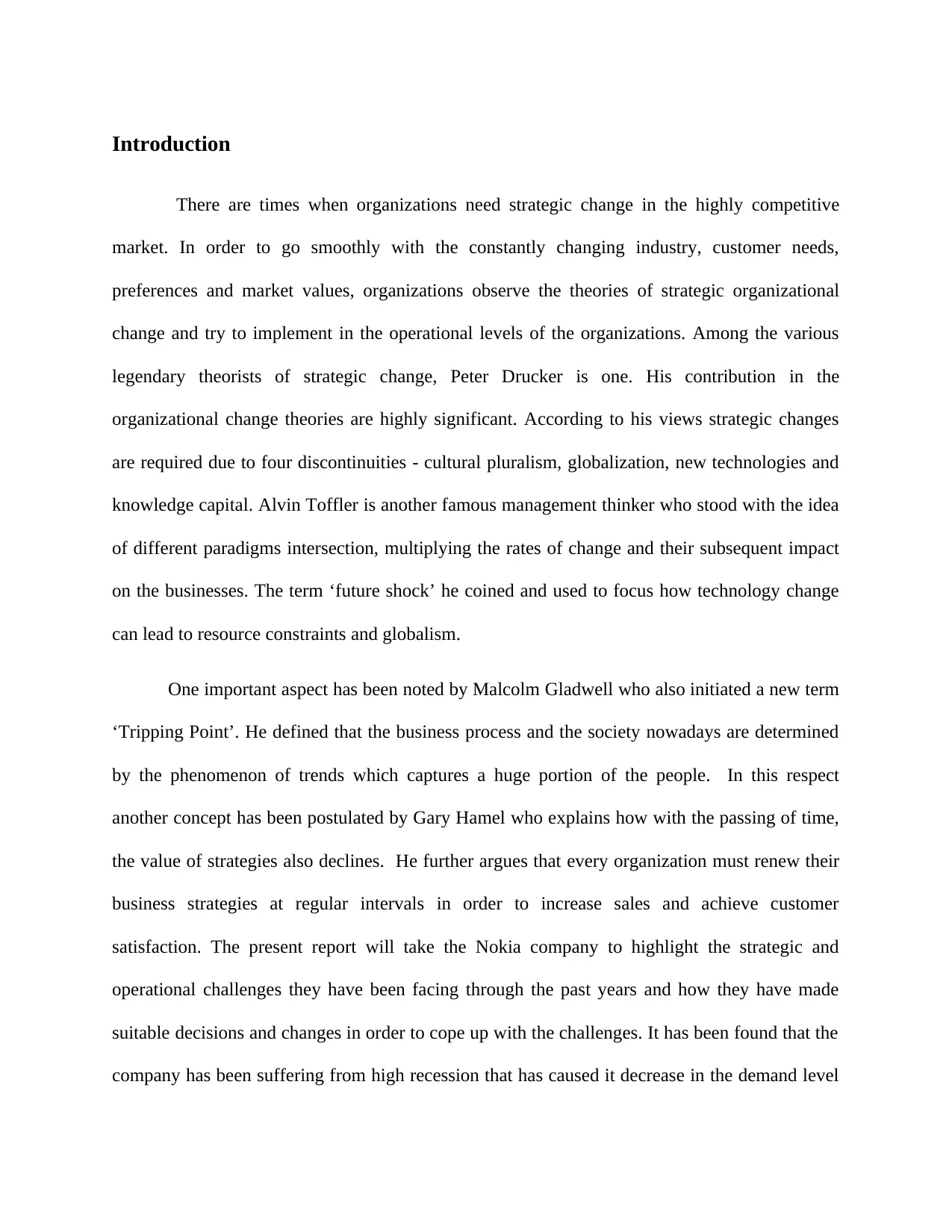
Introduction
There are times when organizations need strategic change in the highly competitive
market. In order to go smoothly with the constantly changing industry, customer needs,
preferences and market values, organizations observe the theories of strategic organizational
change and try to implement in the operational levels of the organizations. Among the various
legendary theorists of strategic change, Peter Drucker is one. His contribution in the
organizational change theories are highly significant. According to his views strategic changes
are required due to four discontinuities - cultural pluralism, globalization, new technologies and
knowledge capital. Alvin Toffler is another famous management thinker who stood with the idea
of different paradigms intersection, multiplying the rates of change and their subsequent impact
on the businesses. The term ‘future shock’ he coined and used to focus how technology change
can lead to resource constraints and globalism.
One important aspect has been noted by Malcolm Gladwell who also initiated a new term
‘Tripping Point’. He defined that the business process and the society nowadays are determined
by the phenomenon of trends which captures a huge portion of the people. In this respect
another concept has been postulated by Gary Hamel who explains how with the passing of time,
the value of strategies also declines. He further argues that every organization must renew their
business strategies at regular intervals in order to increase sales and achieve customer
satisfaction. The present report will take the Nokia company to highlight the strategic and
operational challenges they have been facing through the past years and how they have made
suitable decisions and changes in order to cope up with the challenges. It has been found that the
company has been suffering from high recession that has caused it decrease in the demand level
There are times when organizations need strategic change in the highly competitive
market. In order to go smoothly with the constantly changing industry, customer needs,
preferences and market values, organizations observe the theories of strategic organizational
change and try to implement in the operational levels of the organizations. Among the various
legendary theorists of strategic change, Peter Drucker is one. His contribution in the
organizational change theories are highly significant. According to his views strategic changes
are required due to four discontinuities - cultural pluralism, globalization, new technologies and
knowledge capital. Alvin Toffler is another famous management thinker who stood with the idea
of different paradigms intersection, multiplying the rates of change and their subsequent impact
on the businesses. The term ‘future shock’ he coined and used to focus how technology change
can lead to resource constraints and globalism.
One important aspect has been noted by Malcolm Gladwell who also initiated a new term
‘Tripping Point’. He defined that the business process and the society nowadays are determined
by the phenomenon of trends which captures a huge portion of the people. In this respect
another concept has been postulated by Gary Hamel who explains how with the passing of time,
the value of strategies also declines. He further argues that every organization must renew their
business strategies at regular intervals in order to increase sales and achieve customer
satisfaction. The present report will take the Nokia company to highlight the strategic and
operational challenges they have been facing through the past years and how they have made
suitable decisions and changes in order to cope up with the challenges. It has been found that the
company has been suffering from high recession that has caused it decrease in the demand level
⊘ This is a preview!⊘
Do you want full access?
Subscribe today to unlock all pages.

Trusted by 1+ million students worldwide
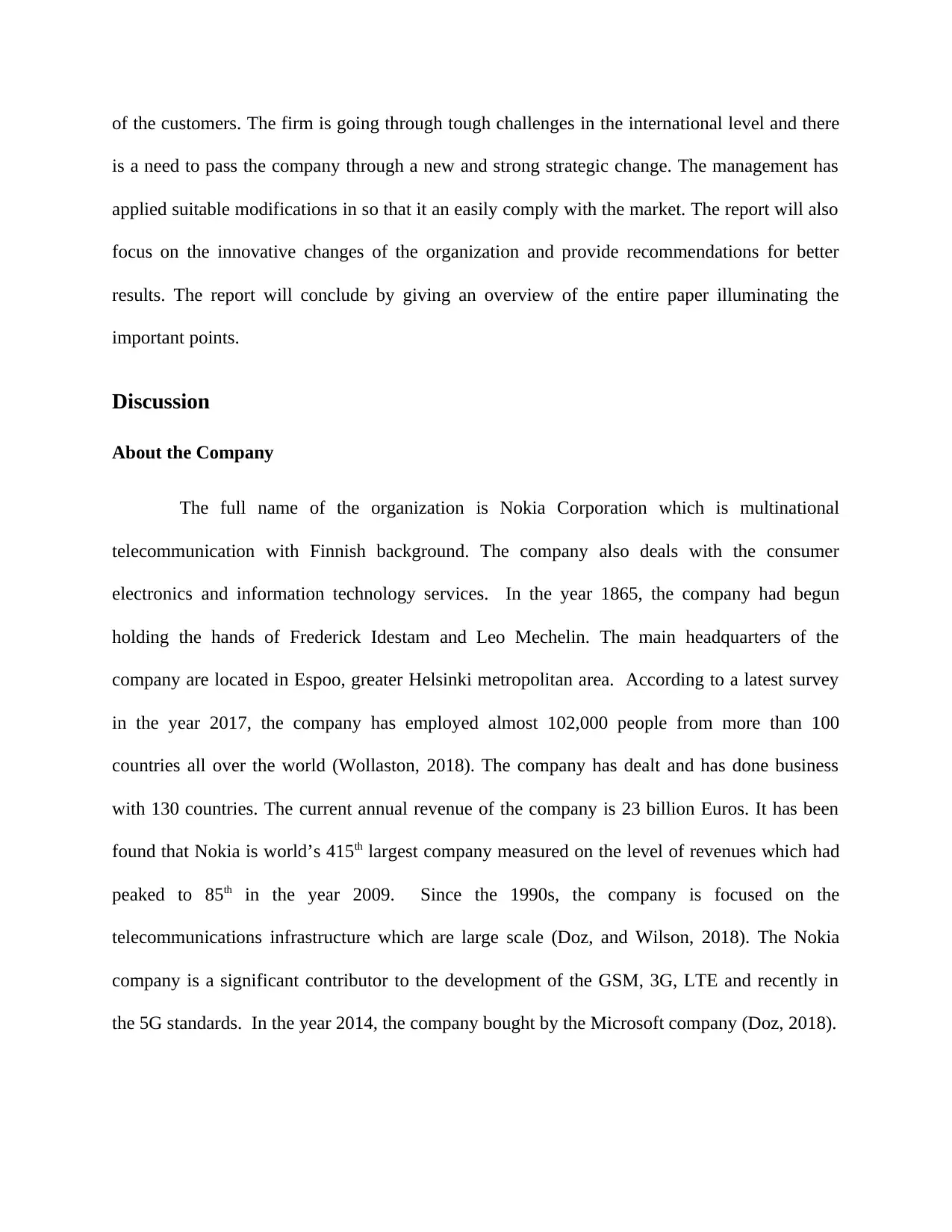
of the customers. The firm is going through tough challenges in the international level and there
is a need to pass the company through a new and strong strategic change. The management has
applied suitable modifications in so that it an easily comply with the market. The report will also
focus on the innovative changes of the organization and provide recommendations for better
results. The report will conclude by giving an overview of the entire paper illuminating the
important points.
Discussion
About the Company
The full name of the organization is Nokia Corporation which is multinational
telecommunication with Finnish background. The company also deals with the consumer
electronics and information technology services. In the year 1865, the company had begun
holding the hands of Frederick Idestam and Leo Mechelin. The main headquarters of the
company are located in Espoo, greater Helsinki metropolitan area. According to a latest survey
in the year 2017, the company has employed almost 102,000 people from more than 100
countries all over the world (Wollaston, 2018). The company has dealt and has done business
with 130 countries. The current annual revenue of the company is 23 billion Euros. It has been
found that Nokia is world’s 415th largest company measured on the level of revenues which had
peaked to 85th in the year 2009. Since the 1990s, the company is focused on the
telecommunications infrastructure which are large scale (Doz, and Wilson, 2018). The Nokia
company is a significant contributor to the development of the GSM, 3G, LTE and recently in
the 5G standards. In the year 2014, the company bought by the Microsoft company (Doz, 2018).
is a need to pass the company through a new and strong strategic change. The management has
applied suitable modifications in so that it an easily comply with the market. The report will also
focus on the innovative changes of the organization and provide recommendations for better
results. The report will conclude by giving an overview of the entire paper illuminating the
important points.
Discussion
About the Company
The full name of the organization is Nokia Corporation which is multinational
telecommunication with Finnish background. The company also deals with the consumer
electronics and information technology services. In the year 1865, the company had begun
holding the hands of Frederick Idestam and Leo Mechelin. The main headquarters of the
company are located in Espoo, greater Helsinki metropolitan area. According to a latest survey
in the year 2017, the company has employed almost 102,000 people from more than 100
countries all over the world (Wollaston, 2018). The company has dealt and has done business
with 130 countries. The current annual revenue of the company is 23 billion Euros. It has been
found that Nokia is world’s 415th largest company measured on the level of revenues which had
peaked to 85th in the year 2009. Since the 1990s, the company is focused on the
telecommunications infrastructure which are large scale (Doz, and Wilson, 2018). The Nokia
company is a significant contributor to the development of the GSM, 3G, LTE and recently in
the 5G standards. In the year 2014, the company bought by the Microsoft company (Doz, 2018).
Paraphrase This Document
Need a fresh take? Get an instant paraphrase of this document with our AI Paraphraser
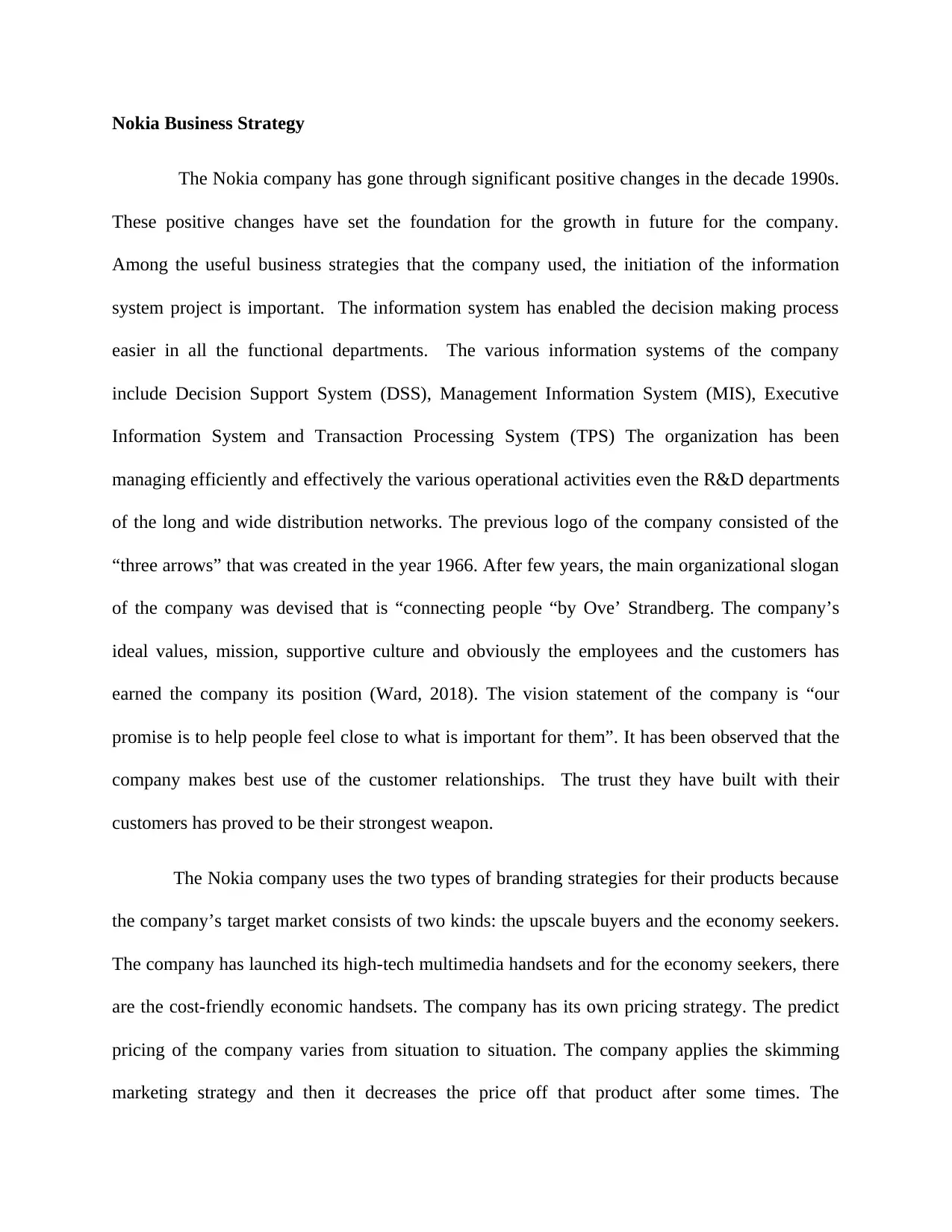
Nokia Business Strategy
The Nokia company has gone through significant positive changes in the decade 1990s.
These positive changes have set the foundation for the growth in future for the company.
Among the useful business strategies that the company used, the initiation of the information
system project is important. The information system has enabled the decision making process
easier in all the functional departments. The various information systems of the company
include Decision Support System (DSS), Management Information System (MIS), Executive
Information System and Transaction Processing System (TPS) The organization has been
managing efficiently and effectively the various operational activities even the R&D departments
of the long and wide distribution networks. The previous logo of the company consisted of the
“three arrows” that was created in the year 1966. After few years, the main organizational slogan
of the company was devised that is “connecting people “by Ove’ Strandberg. The company’s
ideal values, mission, supportive culture and obviously the employees and the customers has
earned the company its position (Ward, 2018). The vision statement of the company is “our
promise is to help people feel close to what is important for them”. It has been observed that the
company makes best use of the customer relationships. The trust they have built with their
customers has proved to be their strongest weapon.
The Nokia company uses the two types of branding strategies for their products because
the company’s target market consists of two kinds: the upscale buyers and the economy seekers.
The company has launched its high-tech multimedia handsets and for the economy seekers, there
are the cost-friendly economic handsets. The company has its own pricing strategy. The predict
pricing of the company varies from situation to situation. The company applies the skimming
marketing strategy and then it decreases the price off that product after some times. The
The Nokia company has gone through significant positive changes in the decade 1990s.
These positive changes have set the foundation for the growth in future for the company.
Among the useful business strategies that the company used, the initiation of the information
system project is important. The information system has enabled the decision making process
easier in all the functional departments. The various information systems of the company
include Decision Support System (DSS), Management Information System (MIS), Executive
Information System and Transaction Processing System (TPS) The organization has been
managing efficiently and effectively the various operational activities even the R&D departments
of the long and wide distribution networks. The previous logo of the company consisted of the
“three arrows” that was created in the year 1966. After few years, the main organizational slogan
of the company was devised that is “connecting people “by Ove’ Strandberg. The company’s
ideal values, mission, supportive culture and obviously the employees and the customers has
earned the company its position (Ward, 2018). The vision statement of the company is “our
promise is to help people feel close to what is important for them”. It has been observed that the
company makes best use of the customer relationships. The trust they have built with their
customers has proved to be their strongest weapon.
The Nokia company uses the two types of branding strategies for their products because
the company’s target market consists of two kinds: the upscale buyers and the economy seekers.
The company has launched its high-tech multimedia handsets and for the economy seekers, there
are the cost-friendly economic handsets. The company has its own pricing strategy. The predict
pricing of the company varies from situation to situation. The company applies the skimming
marketing strategy and then it decreases the price off that product after some times. The
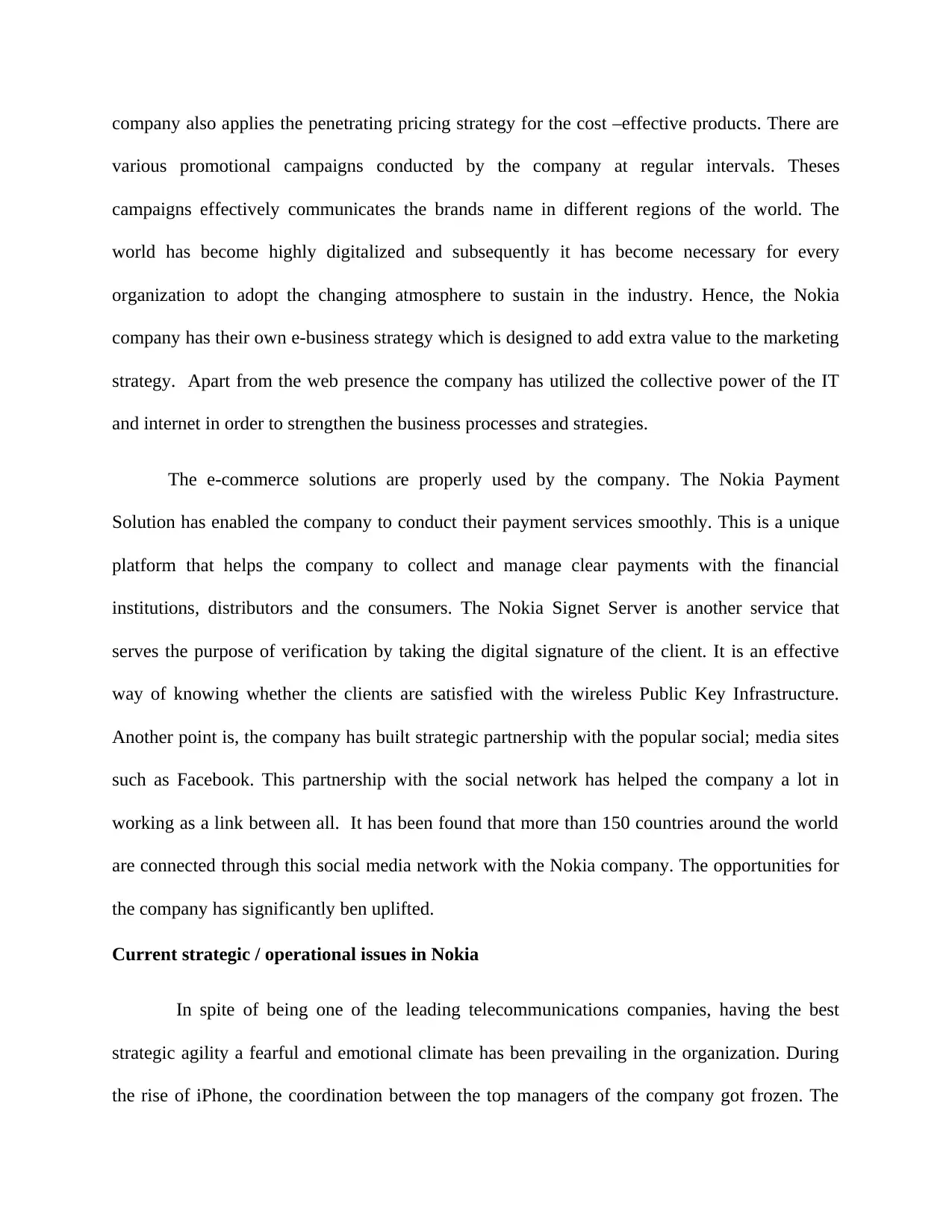
company also applies the penetrating pricing strategy for the cost –effective products. There are
various promotional campaigns conducted by the company at regular intervals. Theses
campaigns effectively communicates the brands name in different regions of the world. The
world has become highly digitalized and subsequently it has become necessary for every
organization to adopt the changing atmosphere to sustain in the industry. Hence, the Nokia
company has their own e-business strategy which is designed to add extra value to the marketing
strategy. Apart from the web presence the company has utilized the collective power of the IT
and internet in order to strengthen the business processes and strategies.
The e-commerce solutions are properly used by the company. The Nokia Payment
Solution has enabled the company to conduct their payment services smoothly. This is a unique
platform that helps the company to collect and manage clear payments with the financial
institutions, distributors and the consumers. The Nokia Signet Server is another service that
serves the purpose of verification by taking the digital signature of the client. It is an effective
way of knowing whether the clients are satisfied with the wireless Public Key Infrastructure.
Another point is, the company has built strategic partnership with the popular social; media sites
such as Facebook. This partnership with the social network has helped the company a lot in
working as a link between all. It has been found that more than 150 countries around the world
are connected through this social media network with the Nokia company. The opportunities for
the company has significantly ben uplifted.
Current strategic / operational issues in Nokia
In spite of being one of the leading telecommunications companies, having the best
strategic agility a fearful and emotional climate has been prevailing in the organization. During
the rise of iPhone, the coordination between the top managers of the company got frozen. The
various promotional campaigns conducted by the company at regular intervals. Theses
campaigns effectively communicates the brands name in different regions of the world. The
world has become highly digitalized and subsequently it has become necessary for every
organization to adopt the changing atmosphere to sustain in the industry. Hence, the Nokia
company has their own e-business strategy which is designed to add extra value to the marketing
strategy. Apart from the web presence the company has utilized the collective power of the IT
and internet in order to strengthen the business processes and strategies.
The e-commerce solutions are properly used by the company. The Nokia Payment
Solution has enabled the company to conduct their payment services smoothly. This is a unique
platform that helps the company to collect and manage clear payments with the financial
institutions, distributors and the consumers. The Nokia Signet Server is another service that
serves the purpose of verification by taking the digital signature of the client. It is an effective
way of knowing whether the clients are satisfied with the wireless Public Key Infrastructure.
Another point is, the company has built strategic partnership with the popular social; media sites
such as Facebook. This partnership with the social network has helped the company a lot in
working as a link between all. It has been found that more than 150 countries around the world
are connected through this social media network with the Nokia company. The opportunities for
the company has significantly ben uplifted.
Current strategic / operational issues in Nokia
In spite of being one of the leading telecommunications companies, having the best
strategic agility a fearful and emotional climate has been prevailing in the organization. During
the rise of iPhone, the coordination between the top managers of the company got frozen. The
⊘ This is a preview!⊘
Do you want full access?
Subscribe today to unlock all pages.

Trusted by 1+ million students worldwide
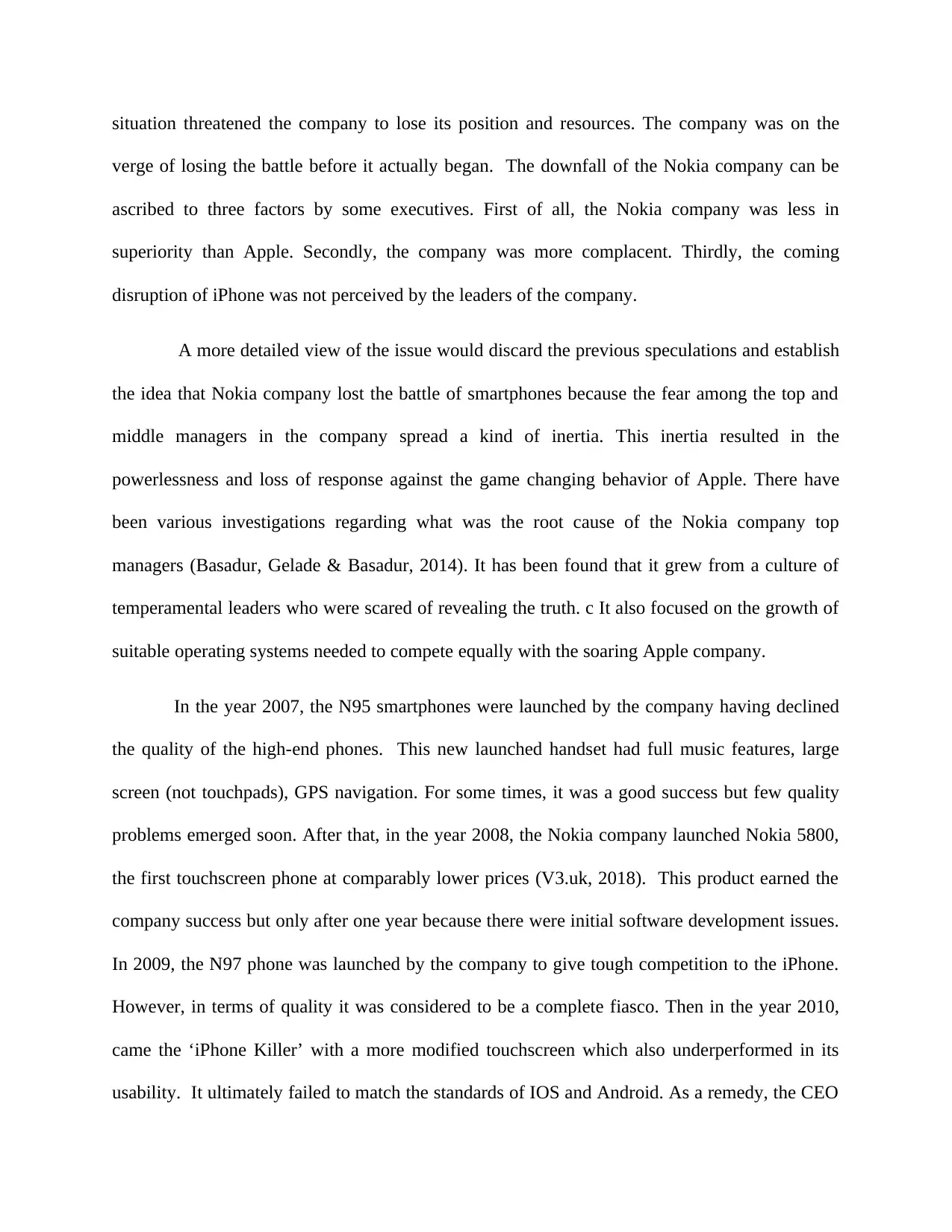
situation threatened the company to lose its position and resources. The company was on the
verge of losing the battle before it actually began. The downfall of the Nokia company can be
ascribed to three factors by some executives. First of all, the Nokia company was less in
superiority than Apple. Secondly, the company was more complacent. Thirdly, the coming
disruption of iPhone was not perceived by the leaders of the company.
A more detailed view of the issue would discard the previous speculations and establish
the idea that Nokia company lost the battle of smartphones because the fear among the top and
middle managers in the company spread a kind of inertia. This inertia resulted in the
powerlessness and loss of response against the game changing behavior of Apple. There have
been various investigations regarding what was the root cause of the Nokia company top
managers (Basadur, Gelade & Basadur, 2014). It has been found that it grew from a culture of
temperamental leaders who were scared of revealing the truth. c It also focused on the growth of
suitable operating systems needed to compete equally with the soaring Apple company.
In the year 2007, the N95 smartphones were launched by the company having declined
the quality of the high-end phones. This new launched handset had full music features, large
screen (not touchpads), GPS navigation. For some times, it was a good success but few quality
problems emerged soon. After that, in the year 2008, the Nokia company launched Nokia 5800,
the first touchscreen phone at comparably lower prices (V3.uk, 2018). This product earned the
company success but only after one year because there were initial software development issues.
In 2009, the N97 phone was launched by the company to give tough competition to the iPhone.
However, in terms of quality it was considered to be a complete fiasco. Then in the year 2010,
came the ‘iPhone Killer’ with a more modified touchscreen which also underperformed in its
usability. It ultimately failed to match the standards of IOS and Android. As a remedy, the CEO
verge of losing the battle before it actually began. The downfall of the Nokia company can be
ascribed to three factors by some executives. First of all, the Nokia company was less in
superiority than Apple. Secondly, the company was more complacent. Thirdly, the coming
disruption of iPhone was not perceived by the leaders of the company.
A more detailed view of the issue would discard the previous speculations and establish
the idea that Nokia company lost the battle of smartphones because the fear among the top and
middle managers in the company spread a kind of inertia. This inertia resulted in the
powerlessness and loss of response against the game changing behavior of Apple. There have
been various investigations regarding what was the root cause of the Nokia company top
managers (Basadur, Gelade & Basadur, 2014). It has been found that it grew from a culture of
temperamental leaders who were scared of revealing the truth. c It also focused on the growth of
suitable operating systems needed to compete equally with the soaring Apple company.
In the year 2007, the N95 smartphones were launched by the company having declined
the quality of the high-end phones. This new launched handset had full music features, large
screen (not touchpads), GPS navigation. For some times, it was a good success but few quality
problems emerged soon. After that, in the year 2008, the Nokia company launched Nokia 5800,
the first touchscreen phone at comparably lower prices (V3.uk, 2018). This product earned the
company success but only after one year because there were initial software development issues.
In 2009, the N97 phone was launched by the company to give tough competition to the iPhone.
However, in terms of quality it was considered to be a complete fiasco. Then in the year 2010,
came the ‘iPhone Killer’ with a more modified touchscreen which also underperformed in its
usability. It ultimately failed to match the standards of IOS and Android. As a remedy, the CEO
Paraphrase This Document
Need a fresh take? Get an instant paraphrase of this document with our AI Paraphraser
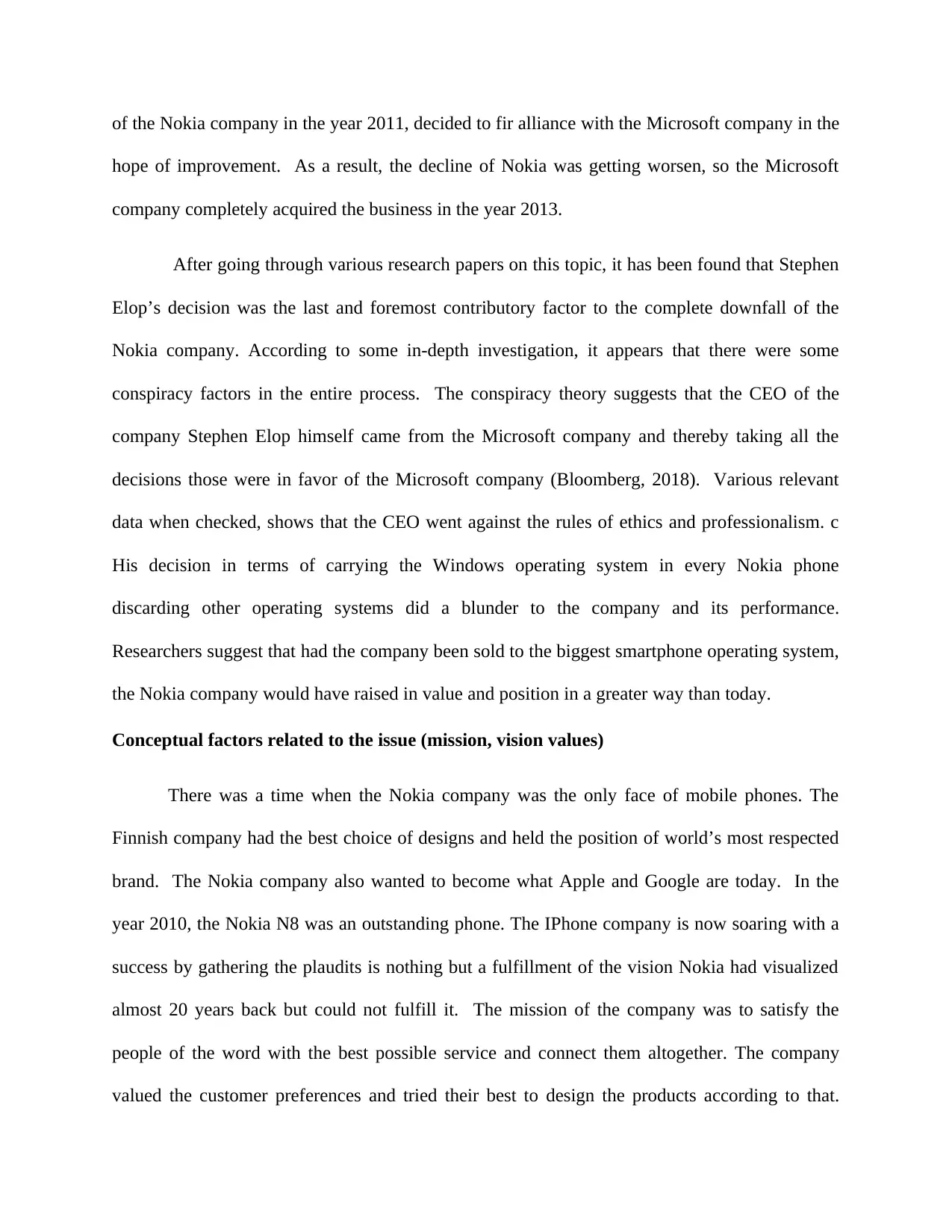
of the Nokia company in the year 2011, decided to fir alliance with the Microsoft company in the
hope of improvement. As a result, the decline of Nokia was getting worsen, so the Microsoft
company completely acquired the business in the year 2013.
After going through various research papers on this topic, it has been found that Stephen
Elop’s decision was the last and foremost contributory factor to the complete downfall of the
Nokia company. According to some in-depth investigation, it appears that there were some
conspiracy factors in the entire process. The conspiracy theory suggests that the CEO of the
company Stephen Elop himself came from the Microsoft company and thereby taking all the
decisions those were in favor of the Microsoft company (Bloomberg, 2018). Various relevant
data when checked, shows that the CEO went against the rules of ethics and professionalism. c
His decision in terms of carrying the Windows operating system in every Nokia phone
discarding other operating systems did a blunder to the company and its performance.
Researchers suggest that had the company been sold to the biggest smartphone operating system,
the Nokia company would have raised in value and position in a greater way than today.
Conceptual factors related to the issue (mission, vision values)
There was a time when the Nokia company was the only face of mobile phones. The
Finnish company had the best choice of designs and held the position of world’s most respected
brand. The Nokia company also wanted to become what Apple and Google are today. In the
year 2010, the Nokia N8 was an outstanding phone. The IPhone company is now soaring with a
success by gathering the plaudits is nothing but a fulfillment of the vision Nokia had visualized
almost 20 years back but could not fulfill it. The mission of the company was to satisfy the
people of the word with the best possible service and connect them altogether. The company
valued the customer preferences and tried their best to design the products according to that.
hope of improvement. As a result, the decline of Nokia was getting worsen, so the Microsoft
company completely acquired the business in the year 2013.
After going through various research papers on this topic, it has been found that Stephen
Elop’s decision was the last and foremost contributory factor to the complete downfall of the
Nokia company. According to some in-depth investigation, it appears that there were some
conspiracy factors in the entire process. The conspiracy theory suggests that the CEO of the
company Stephen Elop himself came from the Microsoft company and thereby taking all the
decisions those were in favor of the Microsoft company (Bloomberg, 2018). Various relevant
data when checked, shows that the CEO went against the rules of ethics and professionalism. c
His decision in terms of carrying the Windows operating system in every Nokia phone
discarding other operating systems did a blunder to the company and its performance.
Researchers suggest that had the company been sold to the biggest smartphone operating system,
the Nokia company would have raised in value and position in a greater way than today.
Conceptual factors related to the issue (mission, vision values)
There was a time when the Nokia company was the only face of mobile phones. The
Finnish company had the best choice of designs and held the position of world’s most respected
brand. The Nokia company also wanted to become what Apple and Google are today. In the
year 2010, the Nokia N8 was an outstanding phone. The IPhone company is now soaring with a
success by gathering the plaudits is nothing but a fulfillment of the vision Nokia had visualized
almost 20 years back but could not fulfill it. The mission of the company was to satisfy the
people of the word with the best possible service and connect them altogether. The company
valued the customer preferences and tried their best to design the products according to that.
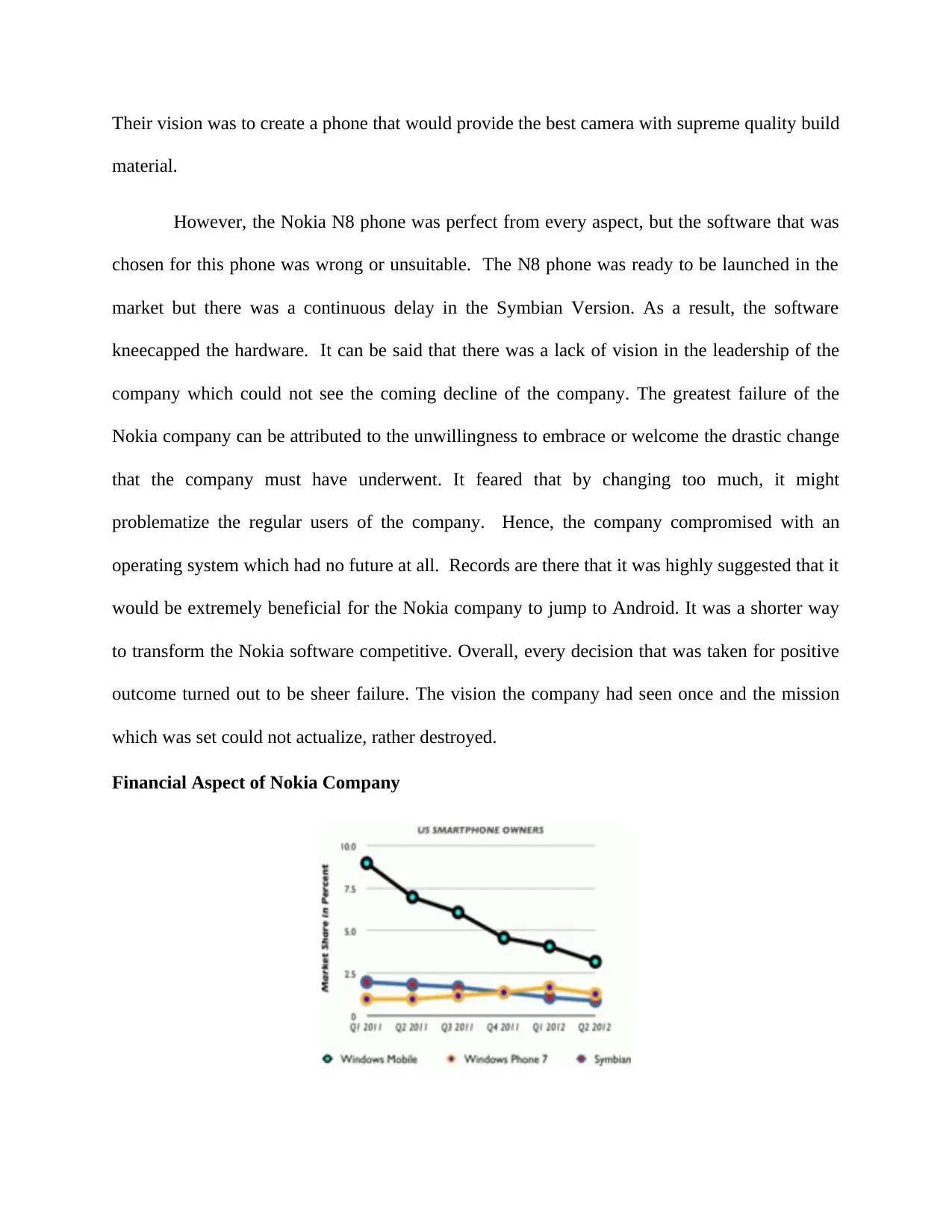
Their vision was to create a phone that would provide the best camera with supreme quality build
material.
However, the Nokia N8 phone was perfect from every aspect, but the software that was
chosen for this phone was wrong or unsuitable. The N8 phone was ready to be launched in the
market but there was a continuous delay in the Symbian Version. As a result, the software
kneecapped the hardware. It can be said that there was a lack of vision in the leadership of the
company which could not see the coming decline of the company. The greatest failure of the
Nokia company can be attributed to the unwillingness to embrace or welcome the drastic change
that the company must have underwent. It feared that by changing too much, it might
problematize the regular users of the company. Hence, the company compromised with an
operating system which had no future at all. Records are there that it was highly suggested that it
would be extremely beneficial for the Nokia company to jump to Android. It was a shorter way
to transform the Nokia software competitive. Overall, every decision that was taken for positive
outcome turned out to be sheer failure. The vision the company had seen once and the mission
which was set could not actualize, rather destroyed.
Financial Aspect of Nokia Company
material.
However, the Nokia N8 phone was perfect from every aspect, but the software that was
chosen for this phone was wrong or unsuitable. The N8 phone was ready to be launched in the
market but there was a continuous delay in the Symbian Version. As a result, the software
kneecapped the hardware. It can be said that there was a lack of vision in the leadership of the
company which could not see the coming decline of the company. The greatest failure of the
Nokia company can be attributed to the unwillingness to embrace or welcome the drastic change
that the company must have underwent. It feared that by changing too much, it might
problematize the regular users of the company. Hence, the company compromised with an
operating system which had no future at all. Records are there that it was highly suggested that it
would be extremely beneficial for the Nokia company to jump to Android. It was a shorter way
to transform the Nokia software competitive. Overall, every decision that was taken for positive
outcome turned out to be sheer failure. The vision the company had seen once and the mission
which was set could not actualize, rather destroyed.
Financial Aspect of Nokia Company
⊘ This is a preview!⊘
Do you want full access?
Subscribe today to unlock all pages.

Trusted by 1+ million students worldwide

Figure 1- Market share of Smartphones
Source – (Bandible.com, 2018)
Source – (Bandible.com, 2018)
Paraphrase This Document
Need a fresh take? Get an instant paraphrase of this document with our AI Paraphraser
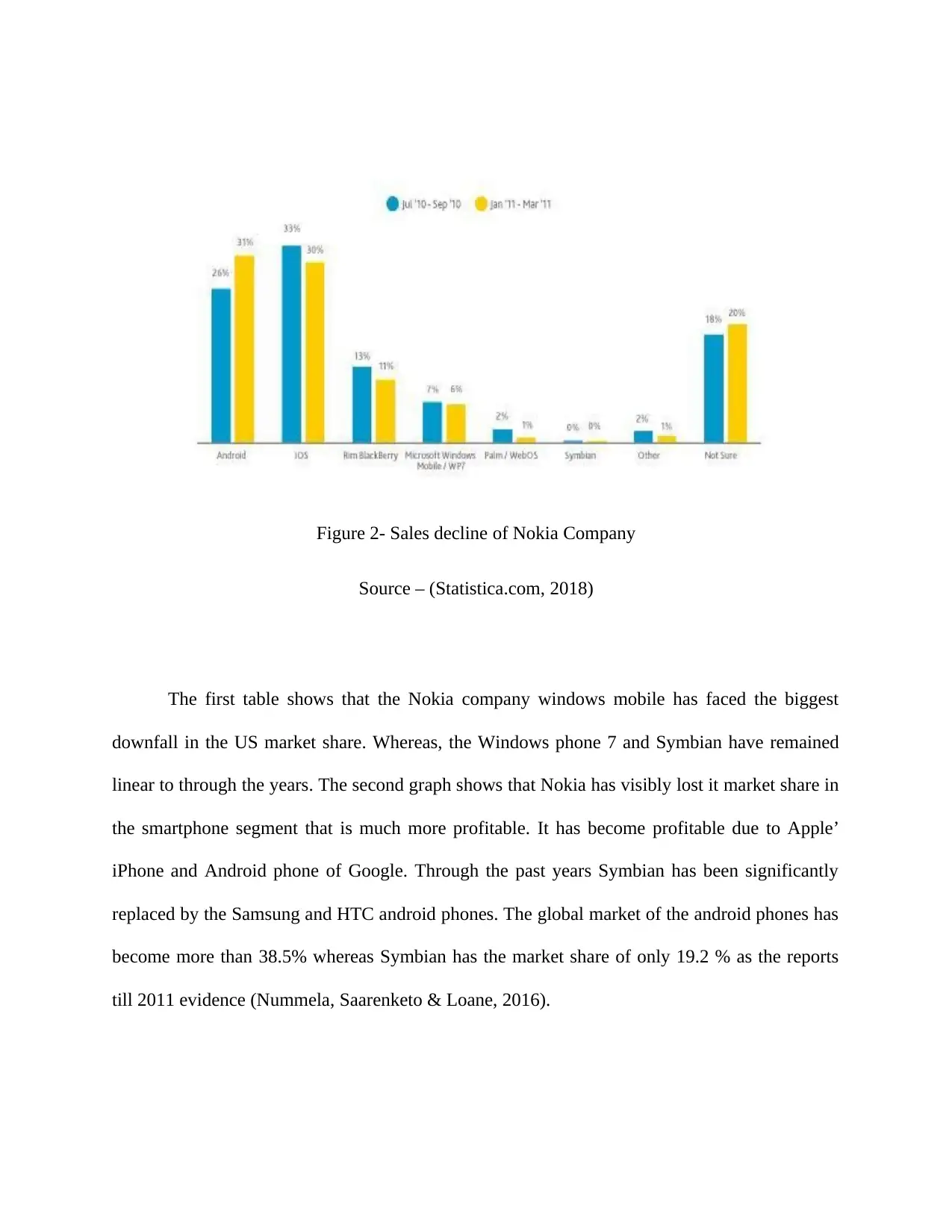
Figure 2- Sales decline of Nokia Company
Source – (Statistica.com, 2018)
The first table shows that the Nokia company windows mobile has faced the biggest
downfall in the US market share. Whereas, the Windows phone 7 and Symbian have remained
linear to through the years. The second graph shows that Nokia has visibly lost it market share in
the smartphone segment that is much more profitable. It has become profitable due to Apple’
iPhone and Android phone of Google. Through the past years Symbian has been significantly
replaced by the Samsung and HTC android phones. The global market of the android phones has
become more than 38.5% whereas Symbian has the market share of only 19.2 % as the reports
till 2011 evidence (Nummela, Saarenketo & Loane, 2016).
Source – (Statistica.com, 2018)
The first table shows that the Nokia company windows mobile has faced the biggest
downfall in the US market share. Whereas, the Windows phone 7 and Symbian have remained
linear to through the years. The second graph shows that Nokia has visibly lost it market share in
the smartphone segment that is much more profitable. It has become profitable due to Apple’
iPhone and Android phone of Google. Through the past years Symbian has been significantly
replaced by the Samsung and HTC android phones. The global market of the android phones has
become more than 38.5% whereas Symbian has the market share of only 19.2 % as the reports
till 2011 evidence (Nummela, Saarenketo & Loane, 2016).
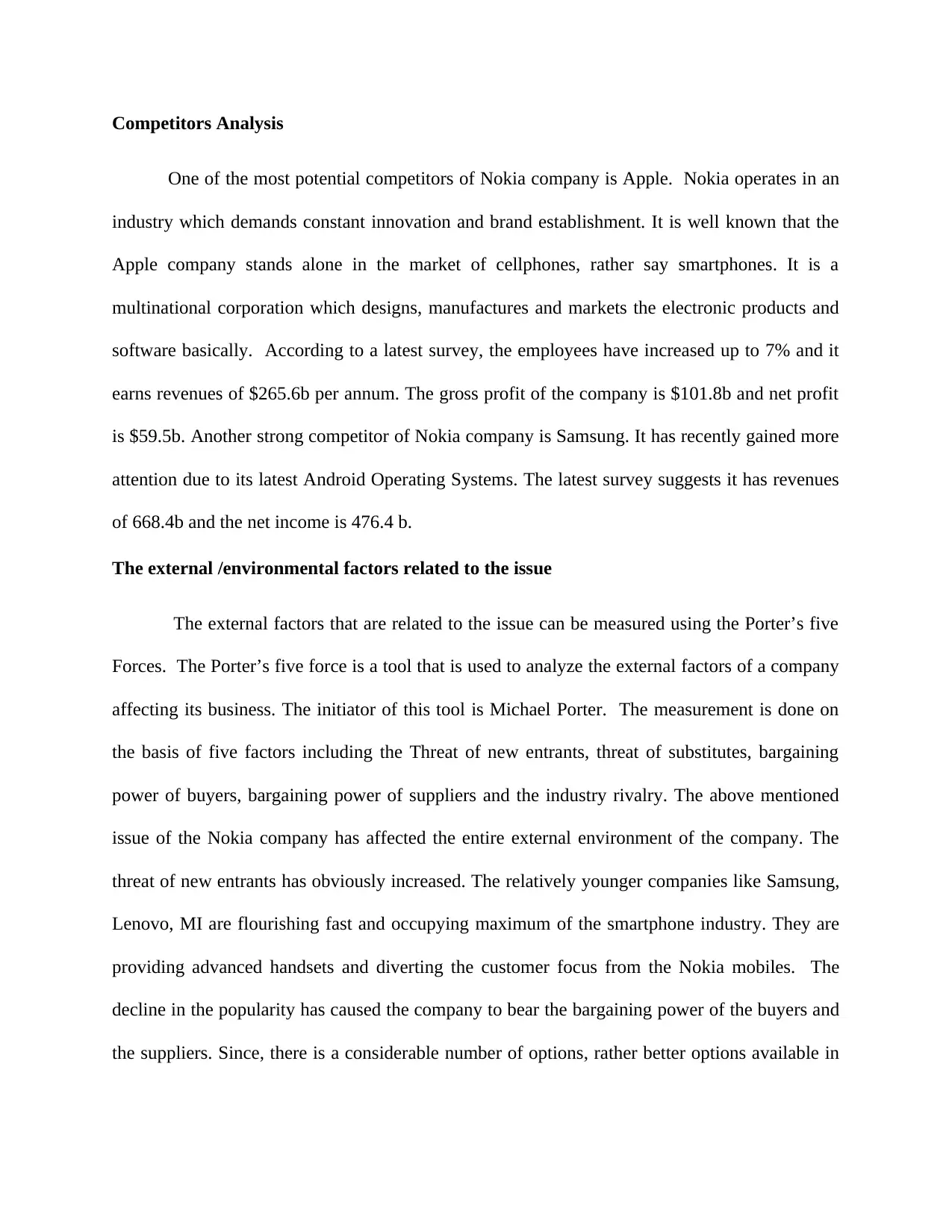
Competitors Analysis
One of the most potential competitors of Nokia company is Apple. Nokia operates in an
industry which demands constant innovation and brand establishment. It is well known that the
Apple company stands alone in the market of cellphones, rather say smartphones. It is a
multinational corporation which designs, manufactures and markets the electronic products and
software basically. According to a latest survey, the employees have increased up to 7% and it
earns revenues of $265.6b per annum. The gross profit of the company is $101.8b and net profit
is $59.5b. Another strong competitor of Nokia company is Samsung. It has recently gained more
attention due to its latest Android Operating Systems. The latest survey suggests it has revenues
of 668.4b and the net income is 476.4 b.
The external /environmental factors related to the issue
The external factors that are related to the issue can be measured using the Porter’s five
Forces. The Porter’s five force is a tool that is used to analyze the external factors of a company
affecting its business. The initiator of this tool is Michael Porter. The measurement is done on
the basis of five factors including the Threat of new entrants, threat of substitutes, bargaining
power of buyers, bargaining power of suppliers and the industry rivalry. The above mentioned
issue of the Nokia company has affected the entire external environment of the company. The
threat of new entrants has obviously increased. The relatively younger companies like Samsung,
Lenovo, MI are flourishing fast and occupying maximum of the smartphone industry. They are
providing advanced handsets and diverting the customer focus from the Nokia mobiles. The
decline in the popularity has caused the company to bear the bargaining power of the buyers and
the suppliers. Since, there is a considerable number of options, rather better options available in
One of the most potential competitors of Nokia company is Apple. Nokia operates in an
industry which demands constant innovation and brand establishment. It is well known that the
Apple company stands alone in the market of cellphones, rather say smartphones. It is a
multinational corporation which designs, manufactures and markets the electronic products and
software basically. According to a latest survey, the employees have increased up to 7% and it
earns revenues of $265.6b per annum. The gross profit of the company is $101.8b and net profit
is $59.5b. Another strong competitor of Nokia company is Samsung. It has recently gained more
attention due to its latest Android Operating Systems. The latest survey suggests it has revenues
of 668.4b and the net income is 476.4 b.
The external /environmental factors related to the issue
The external factors that are related to the issue can be measured using the Porter’s five
Forces. The Porter’s five force is a tool that is used to analyze the external factors of a company
affecting its business. The initiator of this tool is Michael Porter. The measurement is done on
the basis of five factors including the Threat of new entrants, threat of substitutes, bargaining
power of buyers, bargaining power of suppliers and the industry rivalry. The above mentioned
issue of the Nokia company has affected the entire external environment of the company. The
threat of new entrants has obviously increased. The relatively younger companies like Samsung,
Lenovo, MI are flourishing fast and occupying maximum of the smartphone industry. They are
providing advanced handsets and diverting the customer focus from the Nokia mobiles. The
decline in the popularity has caused the company to bear the bargaining power of the buyers and
the suppliers. Since, there is a considerable number of options, rather better options available in
⊘ This is a preview!⊘
Do you want full access?
Subscribe today to unlock all pages.

Trusted by 1+ million students worldwide
1 out of 19
Related Documents
Your All-in-One AI-Powered Toolkit for Academic Success.
+13062052269
info@desklib.com
Available 24*7 on WhatsApp / Email
![[object Object]](/_next/static/media/star-bottom.7253800d.svg)
Unlock your academic potential
Copyright © 2020–2025 A2Z Services. All Rights Reserved. Developed and managed by ZUCOL.





